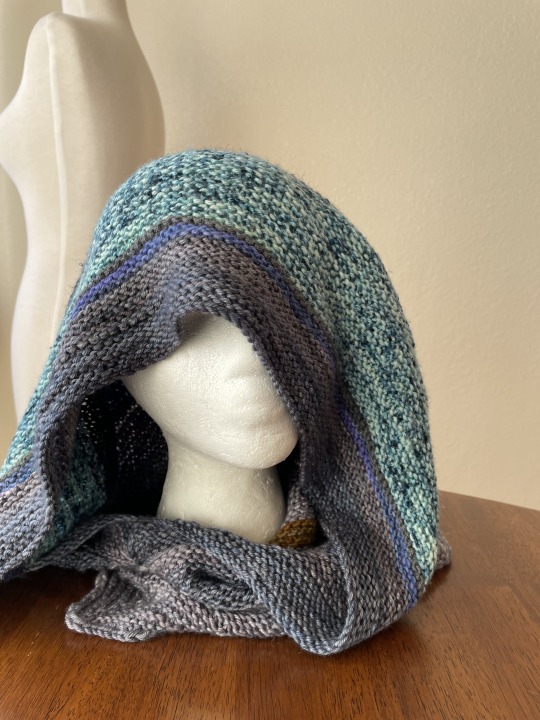#knit cape
Text


Knitting in Victorian England
I wrote this for a class on Victorian Literature because my professor let me research knittinf and make a cape instead of writing a literary analysis paper. The cape that is discussed from The Art of Knitting is what I created for this project, with the illustration from the book on the top right and the cape I knit on the left. The book is from 1892 and is free on Internet Archive, and Engineering Knits on YouTube made a wonderful video about it. (More photos of the cape at the end!)
Knitting experienced a surge of popularity in Victorian England, and was even a topic of discussion in Charlotte Bronte’s Jane Eyre. After gaining popularity due to industrialization, knitting became a common pastime for women. Knitting was important because it existed as a way for Victorian women of all classes to be seen as virtuous and gave them the look of domesticity, while additionally functioning as a means of income for working-class women by either knitting or writing about knitting.
Industrialization shifted the view of knitting from economic necessity to a fashionable pastime for gentry women. In 1589 the first mechanical knitting machine was invented in Nottingham, which industrialized the knitting industry (“The History of Hand-Knitting"). Dyed wool trade with Germany and the subsequent booming industry of knitting pattern books turned knitting into something more accessible and artistic than solely practical (Rutt 112). Knitting became popular and fashionable for gentry women around 1835 (Rutt 111). Women of all classes have knitted long before the Victorian period, but the industrial changes shifted knitting to a popular and fashionable pastime for gentry women, in addition to the economic necessity for working-class women.
Knitting served as a way to keep women wholesomely busy. In The Art of Knitting, a quote from the beginning by Richter reads “A letter or a book distracts a woman more than four pair of stockings knit by herself” (qtd in The Art of Knitting 2). Knitting kept women busy without opening them up to new ideas that came from letters and books. Furthermore, a writer in The Magazine of Domestic Economy writes how useless the items (upper-class) women made were, but praises knitting in its effort “to rid of those hours which, but for their aid, might not be so innocently disposed of” (qtd in Rutt 112). Concentrating on knitting produces something at the end of the hours of challenging work but does not expose women to any material that the Victorians would deem dangerous or immoral. Thus, even when women made something useless, they were keeping themselves busy in a virtuous way.
Knitting also gave women the feminine and domestic look that was expected of them in the Victorian era. This can be seen in Jane Eyre with Jane’s description of Mrs. Fairfax upon their meeting. Jane thinks, “[Mrs. Fairfax] was occupied in knitting; a large cat sat demurely at her feet; nothing in short was wanting to complete the beau-ideal of domestic comfort” (Bronte 145). This is the first time the reader sees Mrs. Fairfax, surrounded by a warm fire, a cat and engaged in a feminine pastime. She is the image of domesticity. Jane admires Mrs. Fairfax, in part, for the comfort her nature, including knitting, brings. Mrs. Fairfax shows the role knitting plays into the idea of women as domestic creatures.
Certain forms of knitting made women appear elegant. Frances Lambert, author of 1842 manual The Handbook of Needlework, advises women to knit using the common Dutch knitting method, in which the yarn is held over the fingers of the left hand and the needles pointed upwards, because it was seen as a more elegant style of knitting (Rutt 113). While Rutt notes that this method was a faster way of knitting, Lambert does not comment on this, but instead focuses on its aesthetic qualities. This style of knitting was popular because it allowed for the look of style that was mandatory in women’s lives.
While gentry women were often restricted to making less practical knit items, some knitting authors disparaged this for frivolity and immorality. Working-class women did not have this criticism as the things they made were out of practicality and meant for regular use. In picking yarn color and material, Mlle Riego de la Branchardiere, author of Ladies Handbook of Knitting, Netting and Crochet writes “...and let her be careful to make all she does a sacrifice acceptable to her God” (qtd in Rutt 116). Rutt asserts that although Victorian knitting is seen as producing useless knits, some authors disparaged this (117). They instead encouraged women to focus on what they saw as the spiritual aspects rather than on aesthetics, as everything women did, including knitting, should enhance their virtue.
While knitting was popular as a pastime, it was still used out of economic need and served as a way for working-class women to earn money. Knitting was taught in orphanages and poor houses, with the first knitting school opened in Lincoln, Leicester, and York in the late 1500s. One school in Yorkshire was established for boys and girls who were “not in affluence” (“The History of Hand-Knitting"). The first knitting book, titled The National Society's Instructions on Needlework and Knitting, published in 1838, was an instructional manual for teachers to teach poor students the art of knitting and needlework. Knitting was used as a personal hobby, but also as a way for working-class people to support themselves.
The importance of knitting to working-class women can be seen in Jane Eyre. St John tells Jane, “It is a village school: your scholars will be only poor girls—cottagers’ children—at the best, farmers’ daughters. Knitting, sewing, reading, writing, ciphering, will be all you will have to teach” (Bronte 541). Knitting will be a way for these young girls to get jobs and to be able to make clothes for themselves and their families. In this way, knitting was more than a fashionable and artistic hobby, but a necessity for many working-class women.
In addition to manufacturing knitwear, women were able to make substantial livings writing about knitting. There was a boom in knitting and needlework publications during the 19th century (“The History of Hand-Knitting"). Some, such as The Art of Knitting, were published directly by publishers with no one associated author. Others were authored by women and were immensely successful. Cornelia Mee, who published shorter pamphlet-type knitting books, sold over 300,000 copies during their run in print (Rutt 115). Francis Lambert, author of two editions of My Knitting Book, sold a combined 65,000 copies and was translated into several languages across Europe (Rutt 113). Knitting gave working-class women opportunities to earn money, whether it was making knitwear or writing about knitting.
Knitting manuals contained various topics, such as some focusing on the religious and virtuous aspects of knitting as discussed previously, but most, if not all, had patterns in them. Under the chapter “Hoods, Capes, Shawls, Jackets, Fascinators, Petticoats, Leggings, Slippers, etc., etc.” in The Art of Knitting there is a pattern to knit a cape. Victorian knitting patterns tended to be broad and vague. Today's patterns are quite concerned with needle size and gauge, unlike many Victorian patterns. For instance, the cape pattern instructs the reader to “use quite coarse needles and work rather loosely,” (60).
Knitting was an important skill for women in the Victorian era, and they knit for a multitude of reasons. Knitting gave women the look of virtue, elegance, and domesticity. Working-class women used their knitting skills to support themselves and their families through making knitwear or writing about knitting.
Sources:
The Art of Knitting. The Butterick Publishing Co. 1892. https://archive.org/details/artofknitting00butt/page/60/mode/2up?ref=ol&vi ew=theater
Bronte, Charlotte. Jane Eyre. Planet eBooks. 1847.
“The History of Hand-Knitting" Victoria and Albert Museum.
Rutt, Richard. A History of Hand Knitting. Interweave Press. 1987. https://archive.org/details/historyofhandkni0000rutt/page/n7/mode/2up?vie w=theater


#knitting#historical knitting#history bounding#Victorian knitting#knitting history#cottagecore#victorian#knit cape#gothic#slow fashion#handmade#my knits
163 notes
·
View notes
Text
Its making a cape time :D

10 notes
·
View notes
Text
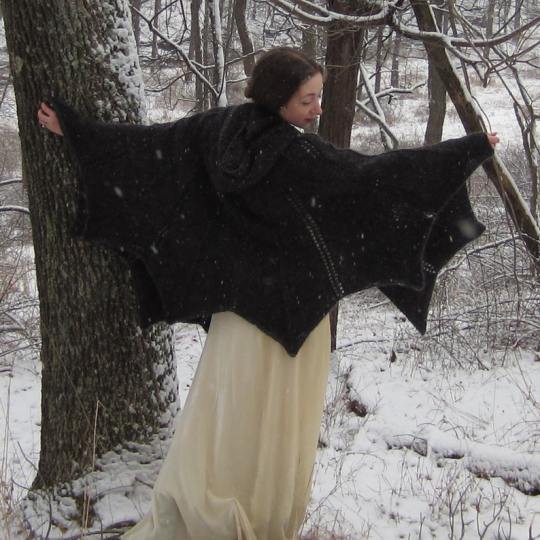
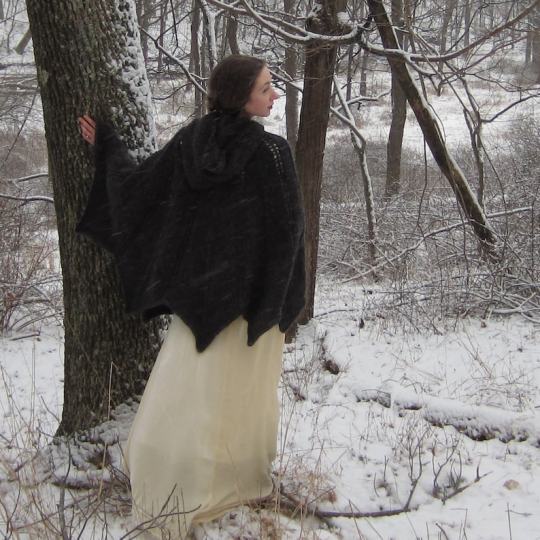
PDF Bat Cape Knitting Pattern - Instant Download by katebellando
#katebellando#knitting pattern#knitting pdf#knitting download#knitting pdf pattern#pdf pattern#pdf download#bat cape#cape#capes#bat#bats#gothic#halloween
2K notes
·
View notes
Text


PDF Bat Cape Knitting Pattern // katebellando
1K notes
·
View notes
Text

Knit and Crochet Shawl Pattern, 1970s.
381 notes
·
View notes
Photo
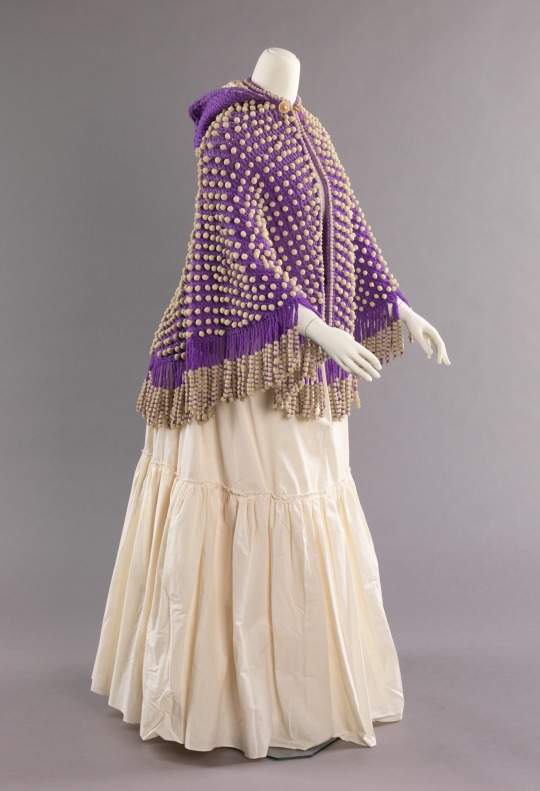
Cape
1873
United States
The MET (Accession Number: 2009.300.2732)
#cape#fashion history#historical fashion#1870s#gilded age#outerwear#19th century#purple#off white#knit#wool#united states#1873#bustle era#the met
354 notes
·
View notes
Text

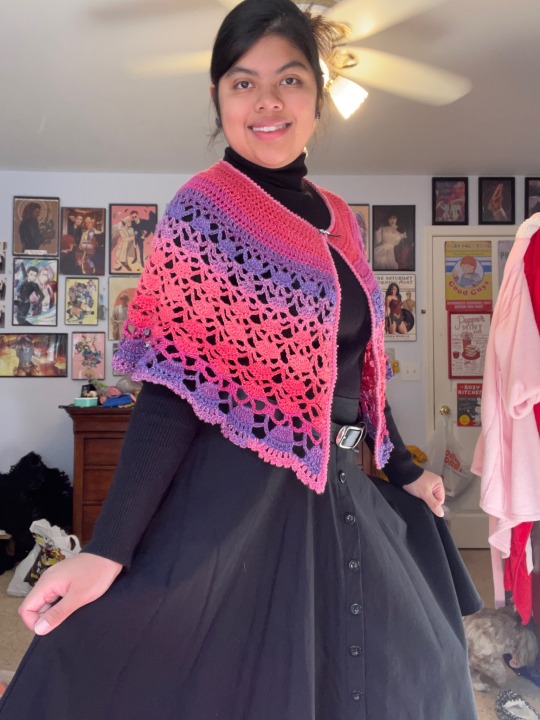

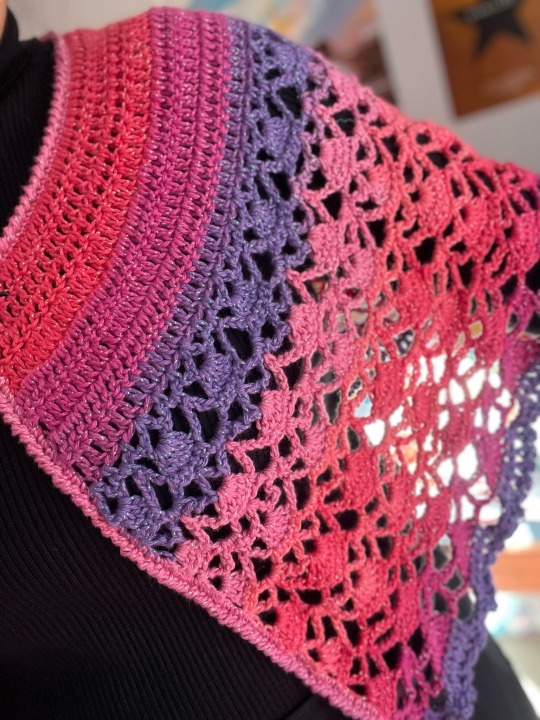
💜 Vintage Styled Purple/Pink/Red Crochet Capelet Available On My Shop 💜
🩷 Original Written Pattern by DesignedBySonya 🩷
#crochet#crocheting#knitting#fashion#vintage#vintage fashion#shawl#cape#capelet#crochet shawl#crochet capelet#crochet cape#my shop
76 notes
·
View notes
Text

Sadaf Taherian
24 notes
·
View notes
Text
MC makes a skirt
mc: *making patterns for a skirt*
lucifer: what are you doing?
mc: i'm making a skirt
lucifer: making- why would you need to make a skirt i can buy it for you.
mc: no can do, luci. i need to do something with my hands or else i'll go insane. besides you guys buy stuff for me all the time, it's fine.
lucifer: okay, if you say so...
[10 minutes later]
mc: hey lucifer? have you seen my skirt i swear left it right here a minute ago...
lucifer: hm? no i haven't seen your skirt. maybe you just misplaced it.
[the next day]
mc: !!!
mc: how did my skirt get here. how is it done and holy shit these stitches are immaculate.
lucifer: you left it in my study.
mc: wait you finished this for me?
lucifer:...no
#i am making a skirt and a cape and maybe extend the sleeves for this cosplay dress#this is how i get my dopamine fix#TELL ME IM WRONG#DO YOU SEE THE VISION#obey me#obey me lucifer#obey me shall we date#obey me lucifer x mc#he knits when he's stressed and has stress-knitted thousands of sweaters#he sews in his very limited free time#pls#can he finish this for me too i havent even started yet and im already stressed
169 notes
·
View notes
Text
kind of a dumb headcanon BUT i think whenever lance actually has some spare time (arceus knows he rarely has any of that) whenever he's not out and about with one of his Various Kids (kanto trio and johto quartet), i think he likes to knit. Specifically so that he can make stuff for the baby dratini in the dragon's den for the winter + stuff like hats and scarves for his own pokemon team. clair does the nearly the Exact Same Thing (crotcheting instead though), however, unlike lance, who would likely be calm about it being discovered (especially since silver would be the most likely to discover it since dad lance is real in my heart), clair would just Drop Kick the discoverer into oblivion (also likely silver. this time because it's funny)
#pokemon#champion lance#gym leader clair#this leads into my headcanon of over time silver getting into art. as a way to express and discover himself and as a form of healing and as#a way of showing vulnerability#so he sees lance knitting for the first time like Huh. You're The Champion what the FUCK are you doing#and eventually when he gets comfortable enough to express an interest in art lance goes out and gets silver the Fanciest most Expensive art#supplies because of course he's going to support silver's passions and help him grow and become a better artist. why wouldn't he#not pictured is lance also knitting scarves hats blankets etc for silver because Stubborn child who Doesn't Wanna bundle up vs. guy who#trains dragons that are Weak to ice#oh also it's funny to imagine clair and lance making each other gag gifts#clair crotchets lance a gag cape that says DONT ASK ME ABOUT DRAGONS (let's be fr lance has the dragon autism) and he wears it for april#fools at the league#i can't Sleep. as you can tell#rival silver#<- for the tags mainyl#MAINYL#.#not trying a 3rd time
19 notes
·
View notes
Text
Okay so I recently learned to crochet and finished a few projects and then got an idea to make accesories for a corgi plushie that an online friend got me and... this is what ended up happening:

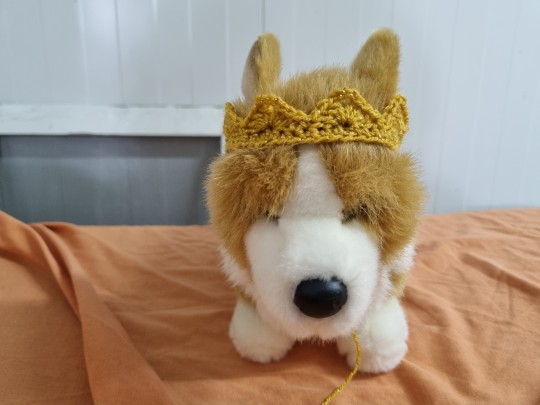

Look at this lil' king! I adore how this turned out it's so cute! I just had to share it hehe I'm so proud of how well this turned out!
#crochet#corgi#plushies#Lily creats#personal post#diy projects#dogs of tumblr#crown and cape#knitting#not sanders sides
28 notes
·
View notes
Photo
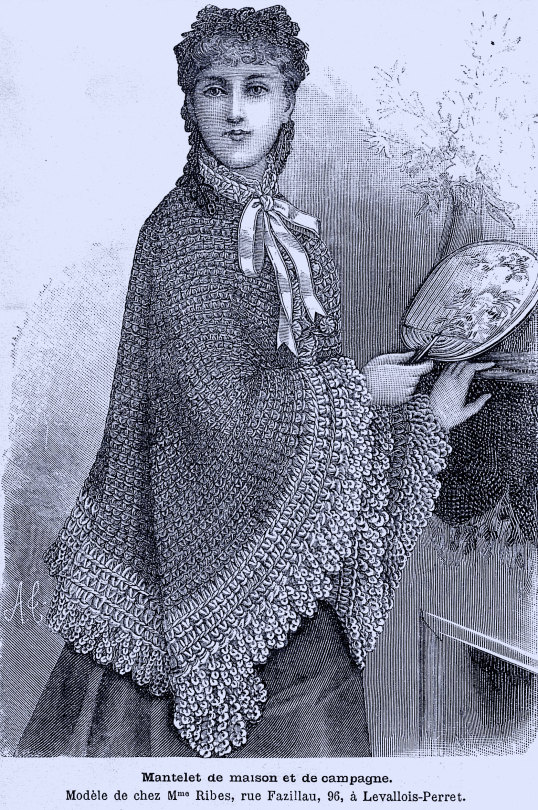
La Mode illustrée, no. 2, 14 janvier 1894, Paris. Mantelet de maison et de campagne. Modèle de chez Mme Ribes, rue Fazillau, 96, à Levallois-Perret. (Laine nécessaire: 590 gr.) Ville de Paris / Bibliothèque Forney
Instructions:
Ce mantelet est fait avec de la laine mastic et un gros crochet de bois; on garnit son bord inférieur et l'encolure avec quelques tours faits en laine bleue; on ferme le mantelet avec des boutons recouverts en laine, des bouclettes de boutons au crochet et un ruban de satin passé au travers des mailles de l'encolure. On travaille depuis l'encolure, en allant et revenant sur une chaînette de 30 mailles:
1er tour. — On passe la plus proche maille, puis toujours 1 maille simple sur la maille suivante.
2e tour. — 1 maille en l'air, — 2 mailles simples sur la plus proche maille simple, — 6 mailles simples sur le côté de devant des 6 plus proches mailles, — 3 fois alternativement pour une augmentation 3 mailles simples sur la maille suivante, — 6 mailles simples comme auparavant sur les 6 plus proches mailles; — on termine en faisant 2 mailles simples sur la dernière maille.
3e au 25e tour. — 1 maille en l'air, — 2 mailles simples sur la 1re maille simple, — puis toujours 1 maille simple sur le côté de devant de la plus proche maille; mais sur la maille de milieu de chaque augmentation on fait une augmentation semblable à la précédente, et sur la dernière maille simple, 2 mailles simples (le 4 derniers tours sont faits avec de la laine bleue). — On garnit ensuit avec de la laine bleue, d'abord le bord de devant de gauche en allant et revenant pour fair 2 tours de mailles simples, et le bord de droite avec un tour de mailles simples; on fait sur ce dernière tour, toujours alternativement, 1 maille simple, — 2 mailles en l'air, — 1 demi-bride, — 1 bride sur la plus proche maille; — on passe 1 maille, et en continuant au bord inférieur*: 1 maille simple sur la plus proche maille, — 7 mailles en l'air, — 1 maille-chaînette sur la 3e de ces mêmes mailles, — 2 mailles en l'air; — on passe 1 maille; — on recommence depuis*. — Ce fait sur les mailles de la chaînette à l'encolure, 3 tours avec de la laine bleue; le premier de ces tours est traversé par le ruban:
1er tour. — 1 maille simple sur la plus proche maille, — toujours alternativement 5 mailles en l'air. — 1 maille simple sur la 2e maille suivante.
2e tour. — 3 mailles en l'air, — toujours alternativement 1 maille-chaînette sur la maille du milieu des 5 plus proches mailles en l'air, — 1 maille en l'air.
3e tour. — Toujours alternativement 3 mailles en l'air, — 3 mailles-chaînettes sur les 3 mailles suivantes. Pour les bouclettes formant des boutonnières, on ferme en cercle 20 mailles en l'air, on les noue au milieu.
—
This cloak is made with mastic wool and a large wooden hook; its lower edge and the neckline are trimmed with a few turns made of blue wool; the cloak is closed with buttons covered in wool, loops of crocheted buttons and a satin ribbon passed through the stitches of the neckline. We work from the neckline, going back and forth on a chain of 30 stitches:
1st round. — Pass the nearest stitch, then always 1 single stitch on the next stitch.
2nd round. — 1 chain stitch, — 2 single stitches on the closest single stitch, — 6 single stitches on the front side of the 6 closest stitches, — 3 times alternately for an increase 3 single stitches on the next stitch, — 6 single stitches as before on the 6 nearest stitches; — we finish by making 2 single stitches on the last stitch.
3rd to 25th rounds. — 1 chain stitch, — 2 single stitches on the 1st single stitch, — then always 1 single stitch on the front side of the nearest stitch; but on the middle stitch of each increase we make an increase similar to the previous one, and on the last single stitch, 2 single stitches (the last 4 rounds are made with blue wool). — We then garnish with blue wool, first the left front edge going back and forth to make 2 rounds of single stitches, and the right edge with a round of single stitches; work on this last round, always alternately, 1 single stitch, — 2 chain stitches, — 1 half double crochet, — 1 double crochet on the nearest stitch; — pass 1 stitch, and continuing to the lower edge*: 1 single stitch on the nearest stitch, — 7 chain stitches, — 1 chain stitch on the 3rd of these same stitches, — 2 chain stitches air; — pass 1 stitch; — we start again since*. — This done on the chain stitches at the neckline, 3 rounds with blue wool; the first of these turns is crossed by the ribbon:
1st round. — 1 single stitch on the closest stitch, — always alternately 5 chain stitches. — 1 single stitch on the next 2nd stitch.
2nd round. — 3 chain stitches, — always alternately 1 chain stitch on the middle stitch of the 5 closest chain stitches, — 1 chain stitch.
3rd round. — Always alternately 3 chain stitches, — 3 chain stitches on the next 3 stitches. For the loops forming buttonholes, we close in a circle 20 stitches in the air, we knot them in the middle.
#La Mode illustrée#19th century#1800s#1890s#1894#periodical#fashion#fashion plate#retouch#description#instructions#knit#crochet#cape#ribbon#Ribes#country#mantle#mantelet
50 notes
·
View notes
Text

The first step of the rough draft is done!
#adventures in knitting#hmmm it’s acrylic do I try to block it and then seam the pieces together#or do I seam everything and then see#in my final wool I’ll definitely steam block here#not sure its worth it for now#fairy cape#my first pattern creation attempt#though I’m copying an existing pattern that’s been pulled down#so it’s not that impressive
15 notes
·
View notes
Text




♥️ Red Vintage-Style Capelet Available On My Shop! ♥️
🌺 Original WRITTEN Pattern by DesignedBySonya 🌺
#crochet#knitting#fashion#vintage#vintage fashion#vintage aesthetic#Christmas#Christmas aesthetic#red#red aesthetic#capes#capelet#my shop
25 notes
·
View notes
